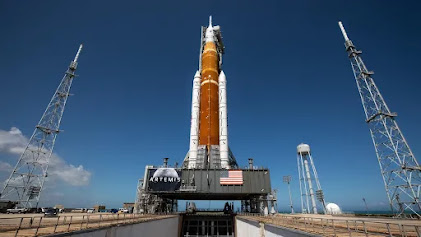Artemis launch attempt

NASA planned an endeavour to
send off its Space Launch System rocket and Orion space apparatus to the moon
Saturday evening, after an endeavour, Monday was dropped when a progression of
issues damaged the work. In a preparation Tuesday night, NASA authorities said
they accept they can figure out the specialised problems that
forestalled the sendoff Monday; however, they keep on forewarning that since this
would stamp the main sendoff of the huge, convoluted rocket, nothing is
ensured.
The sendoff is booked for
2:17 p.m., with a two-hour sendoff window. Climate for a Saturday sendoff
likewise could be interesting, with just a 40 percent chance of good
circumstances. Be that as it may, since there is a two-hour window and showers
are supposed to be irregular along the Florida coast, climate authorities
figure there could be sufficient time between showers for the sendoff to
happen. The sendoff endeavour Monday was cleaned after NASA engineers couldn't
bring down the temperature of one of the motors to what's expected for the sendoff.
The RS-25 motors consume fluid hydrogen fuel, which is kept at short 423
degrees Fahrenheit. To prepare the motors for such a very cool liquid, NASA
drains a smidgen of fuel through so the motors won't be stunned as the fuel
begins flooding in.
Last year, NASA had the
option to fuel the rocket and afterwards fire the four motors for their full
eight-minute term during a test at NASA's Stennis Flight Centre in Mississippi.
In any case, from that point forward, the organisation has battled with getting
the rocket filled and preparing the motors for the sendoff. Honeycutt said Tuesday that NASA engineers were unsure whether the temperature perusing was the consequence
of an inability to cool the motor or a terrible sensor not returning exact
data. Honeycutt expressed that on Monday fluid hydrogen was coursing through
the motors and cooled three of the motors true to form. The fourth, however,
was "thoroughly up" with the others.
supplanting the sensor on the
cushion "would be interesting." Instead, NASA ought to have the
option to let know if the motors are at the right temperature by taking a
gander at a variety of information sources as opposed to depending on a
solitary sensor. Likewise, NASA authorities said they would roll out a
procedural improvement and turn over cooling the motors 30 to 45 minutes
sooner, as they did during the effective test last year in Mississippi, to give
them additional opportunity to take care of any issues. the main thing
that I know to change to duplicate the achievement we had at Stennis is moving
to test prior in the course of events, during a past energising test, NASA
never reached the place where it streamed the fluid hydrogen in light of the
fact that it had a hole, compelling the organisation to end the test prior to
getting to that step. At any rate, Monday the groups realised that could
represent an issue during the sendoff endeavour however chose to continue.
They realise that that was a
gamble added into this sendoff mission, and it would be the initial time
showing that. Monday shielded the choice to continue with the sendoff
endeavour. There were a ton of enquiries of would it be a good idea for us we
have moved back and attempted to do another test. We actually want to go for
now was the best thing to do,
The Artemis programme is an aggressive endeavour by the office to return space travellers to the moon interestingly since the Apollo time. (In Greek folklore, Artemis is the twin sister of Apollo.) The first of the Artemis missions, Artemis I, is intended to send the Orion space apparatus in a circle around the moon with no space travellers ready. The following flight, Artemis II, would send upwards of four space travellers in the case, again to circle however not land on the moon. In the event that all goes to design, an arrival will come at some point in 2025 or 2026.



Comments
Post a Comment